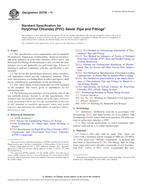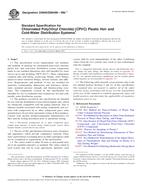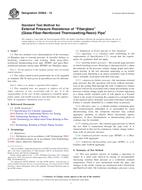Potřebujeme váš souhlas k využití jednotlivých dat, aby se vám mimo jiné mohly ukazovat informace týkající se vašich zájmů. Souhlas udělíte kliknutím na tlačítko „OK“.
ASTM F2263-14
Standard Test Method for Evaluating the Oxidative Resistance of Polyethylene (PE) Pipe to Chlorinated Water
Automaticky přeložený název:
Standardní zkušební metoda pro hodnocení oxidační odporu z polyetylénu (PE) trubky pro chlorované vody
NORMA vydána dne 1.8.2014
Informace o normě:
Označení normy: ASTM F2263-14
Poznámka: NEPLATNÁ
Datum vydání normy: 1.8.2014
Kód zboží: NS-53405
Počet stran: 8
Přibližná hmotnost: 24 g (0.05 liber)
Země: Americká technická norma
Kategorie: Technické normy ASTM
Kategorie - podobné normy:
Anotace textu normy ASTM F2263-14 :
Keywords:
chlorine resistance, oxidative resistance, pipe, polyethylene, ICS Number Code 23.040.20 (Plastic pipes)
Doplňující informace
| Significance and Use | ||||||||||||||
|
5.1 Environment or oxidative time-to-fail data derived from this test method, analyzed in accordance with Section 13, are suitable for extrapolation to typical end-use temperatures and hoop stresses. The extrapolated value(s) provides a relative indication of the resistance of the tested PE pipe or system to the oxidative effects of chlorinated water for conditions equivalent to those conditions under which the test data were obtained. The performance of a material or piping product under actual conditions of installation and use is dependent upon a number of factors including installation methods, use patterns, water quality, nature and magnitude of localized stresses, and other variables of an actual, operating cold water supply or service system that are not addressed in this test method. As such, the extrapolated values do not constitute a representation that a PE pipe or system with a given extrapolated time-to-failure value will perform for that period of time under actual use conditions. 5.2 This test method has been generally used for evaluating oxidatively induced Stage II or Stage III failure data. |
||||||||||||||
| 1. Scope | ||||||||||||||
|
1.1 This test method describes the general requirements for evaluating the long-term, chlorinated water, oxidative resistance of polyethylene (PE), used in cold water supply or service systems by exposure to chlorinated water. This test method outlines the requirements of a pressurized flow-through test system, typical test pressures, test-fluid characteristics, failure type, and data analysis. Note 1: Other known disinfecting systems (chlorine dioxide,
ozone, and chloramine) are currently used for protection of potable
water; however, free-chlorine is by far the most common system in
use today. Disinfecting systems other than chlorine have not been
evaluated by this method.
1.2 Guidelines and requirements for test temperatures, test hoop stresses, and other test criteria have been established by prior testing of PE pipe. Other related system components that typically appear in a PE cold water supply or service system can be evaluated with the PE pipe. When testing PE pipe and fittings as a system, it is recommended that the anticipated end-use fitting type(s) and material(s) be included in the test circuit since it is known that some fitting types and materials can impact failure times. Specimens used shall be representative of the piping product(s) and material(s) under investigation. Note 2: The procedures described in this test method (with
some modifications of test temperatures or stresses, or both) have
been used to evaluate pipes manufactured from polybutylene (PB),
crosslinked polyethylene (PEX), polypropylene (PP), multilayer
(polymer-metal composite), copper, and stainless steel.
1.3 This test method is applicable to PE pipe and systems used for transport of potable water containing free-chlorine for disinfecting purposes. The oxidizing potential of the test-fluid specified in this test method exceeds that typically found in potable water systems across the United States. 1.4 The values stated in inch-pound units are to be regarded as standard. The values given in parentheses are mathematical conversions to SI units that are provided for information only and are not considered standard. 1.5 The following precautionary caveat pertains only to the test method portion, Section 12, of this specification.This standard does not purport to address all of the safety concerns, if any, associated with its use. It is the responsibility of the user of this standard to establish appropriate safety and health practices and determine the applicability of regulatory limitations prior to use. |
||||||||||||||
| 2. Referenced Documents | ||||||||||||||
|
Podobné normy:
Historická
1.2.2011
Historická
1.11.2012
Historická
1.2.2012
Historická
1.8.2009
Historická
1.3.2008
Historická
1.10.2012
Doporučujeme:
EviZak - všechny zákony včetně jejich evidence na jednom místě
Poskytování aktuálních informací o legislativních předpisech vyhlášených ve Sbírce zákonů od roku 1945.
Aktualizace 2x v měsíci !
Chcete vědět více informací? Podívejte se na tuto stránku.



 ASTM D2729-11
ASTM D2729-11 ASTM D2737-12a
ASTM D2737-12a ASTM D2774-12
ASTM D2774-12 ASTM D2846/D2846M-09..
ASTM D2846/D2846M-09.. ASTM D2852-95(2008)..
ASTM D2852-95(2008).. ASTM D2924-12
ASTM D2924-12
 Cookies
Cookies
